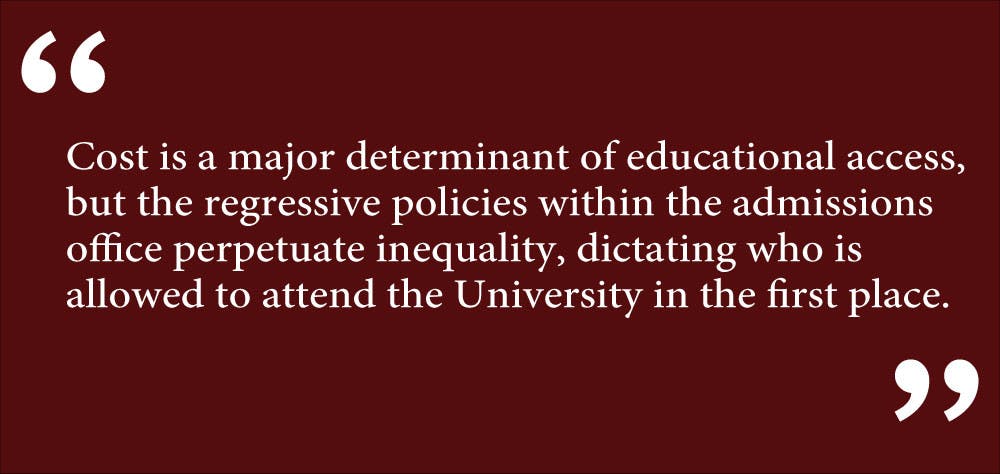President Christina Paxson P ’19 announced Wednesday that the University will launch a $120 million campaign to remove all loans from financial aid packages for all undergraduates and replace them with grants.
This effort displays an important commitment to improving socioeconomic diversity on campus. But while the move is laudable and will help many students, it does little to address the major drivers of entrenched socioeconomic inequality on campus. Cost is a major determinant of educational access, but the regressive policies within the admissions office perpetuate inequality, dictating who is admitted to the University in the first place.
It is no secret that Brown’s student population severely overrepresents the richest Americans. Over 19 percent of Brown students come from the top 1 percent of the income scale, while 18.2 percent come from the bottom 60 percent of the income scale. Moreover, 70 percent of all Brown students come from families in the top 20 percent median family income bracket. This inequality is deeply ingrained in Brown as an institution, and while the University’s new financial aid initiative attempts to alleviate the problem, it doesn’t get at the root cause.
In 2003, the University unveiled its need-blind admissions policy, promising to make a Brown education more accessible to students from all income backgrounds. Eliminating all loans in undergraduate financial aid packages awarded by the University is the next major step in fulfilling this promise. Quite frankly, however, this initiative will do little to alter the skewed economic makeup of the Brown student body. Peer institutions that have implemented similar loan-free financial aid programs continue to struggle with economic diversity on their campuses. Yale, Penn and Princeton all have loan-free aid programs, but the number of students from the top 1 percent still outnumber those from the entire bottom 60 percent. Financial aid programs simply do not affect the student body as much as the admissions protocols that decide who is receives an acceptance letter.
If the University is serious about improving socioeconomic diversity on campus, it must also reform the admissions processes that determine the composition of the student body. The admission office maintains antiquated policies that benefit the rich. Standardized testing, legacy admission and preferences for costly extracurriculars all preserve the very inequality the administration is trying to prevent.
Brown’s reliance upon and use of standardized tests like the SAT and ACT disproportionately benefit the wealthy. Students from the highest income bracket generally outperform the poorest by 400 points on the SAT. This achievement gap is created by a confluence of factors, the largest being test preparation tutoring. Families dole out thousands of dollars to test prep companies in the hopes of improving their children’s standardized test scores, but these materials remain out of reach for most low-income applicants. Similarly, these standardized tests cost significant amounts of money to take and re-take, and subsidies for such costs are limited in quantity. Many have also argued that the language used on these tests benefits students from families who are wealthy and speak English as a native language. In 2003, controversy erupted when an SAT question centered on the word “regatta” — a series of boat or yacht races — which many protested was a word only privileged, coastal Americans would know. Despite all this, Brown relies heavily on these tests, requiring students to take extra “SAT Subject Tests” imposes even more burdensome costs .
The most explicitly regressive policy that promotes inequality and the admission of the wealthiest is legacy admission. As Herald columnist Lena Renshaw ’20 recently wrote, “The University cannot meaningfully offer more opportunities to underrepresented students so long as it clings to legacy admissions, one of the prime engines of inequality.” If Brown wanted to rethink its admissions policy — which effectively reserves between 10 and 12 percent of each year’s seats for the children of alums — it could very easily expand the proportion of low-income students on campus.
And ending legacy admissions doesn’t have to come at the expense of the University’s finances. The Massachusetts Institute of Technology has proven the positive impacts of ending legacy admissions; MIT performs far better than all Ivy League schools in terms of socioeconomic diversity, with 23.4 percents of students coming from the bottom 60 percent of the income scale and only 5.7 percent coming from the top 1 percent — all while maintaining a substantial endowment.
What is perhaps the largest driver of socioeconomic inequality at Brown is the skewed way in which the University treats the qualifications of students from higher income brackets. By focusing on students from elite feeder private schools like Brearley and Trinity schools in New York, which both send over 40 percent of their graduates to the Ivy Leagues — a phenomenon I’ve written about before — the University’s admissions officers undermine their own ability to build socioeconomically diverse classes. Further, overvaluing expensive and exclusive extracurriculars — sports like horseback riding and ice hockey, as well as academic competitions like travel debate — stacks the cards against students from families and school districts that lack vast resources.
The end result of these subtle practices in college admissions — the continued use of standardizing testing, preferences for legacy applicants and preferences for certain extracurriculars — is subconscious discrimination against low-income students. Ultimately, it is fantastic that the University’s administration realizes that socioeconomic inequality on campus is a problem worth tackling, and the elimination of all loans in undergraduate financial aid awards is truly admirable. But they must also address the University’s socioeconomic diversity in realms other than financial aid to truly have an impact.
Owen Colby ’20 can be reached at owen_colby@brown.edu. Please send responses to this opinion to letters@browndailyherald.com and other op-eds to opinions@browndailyherald.com.





